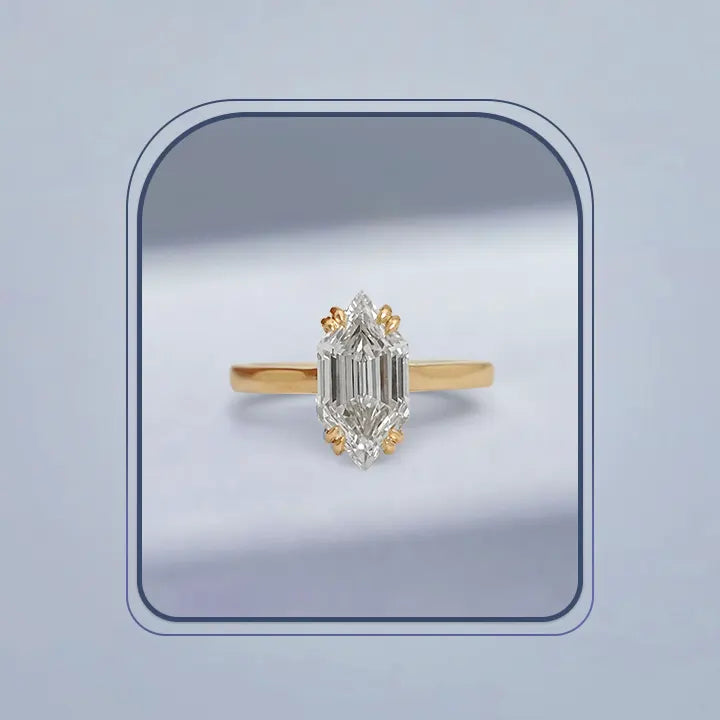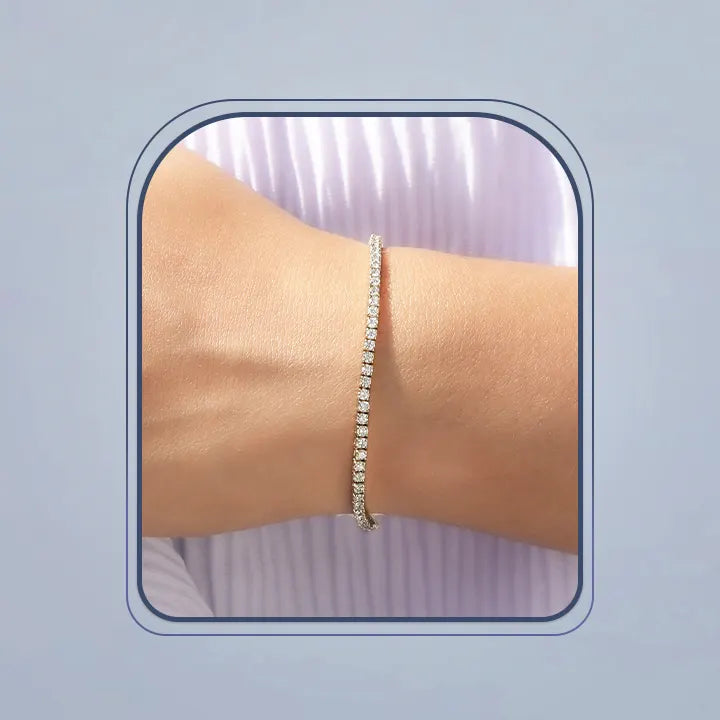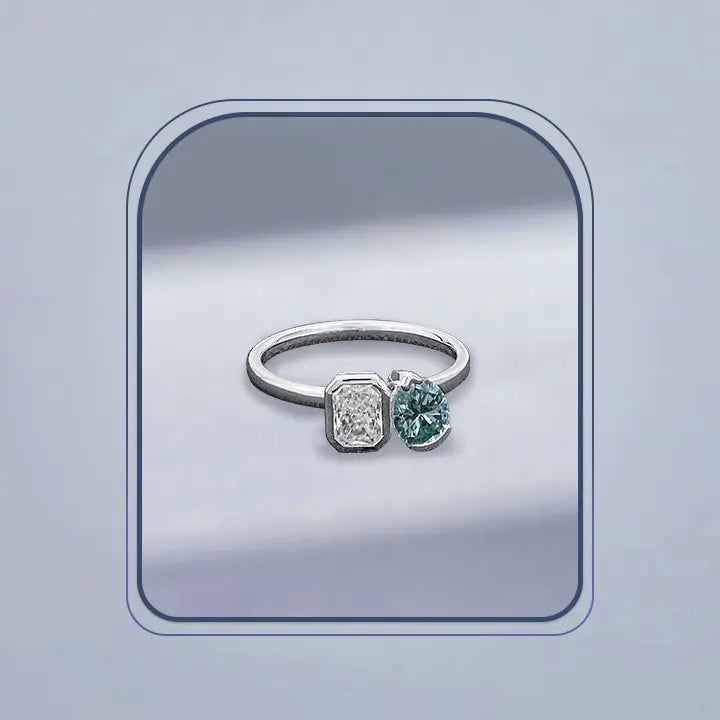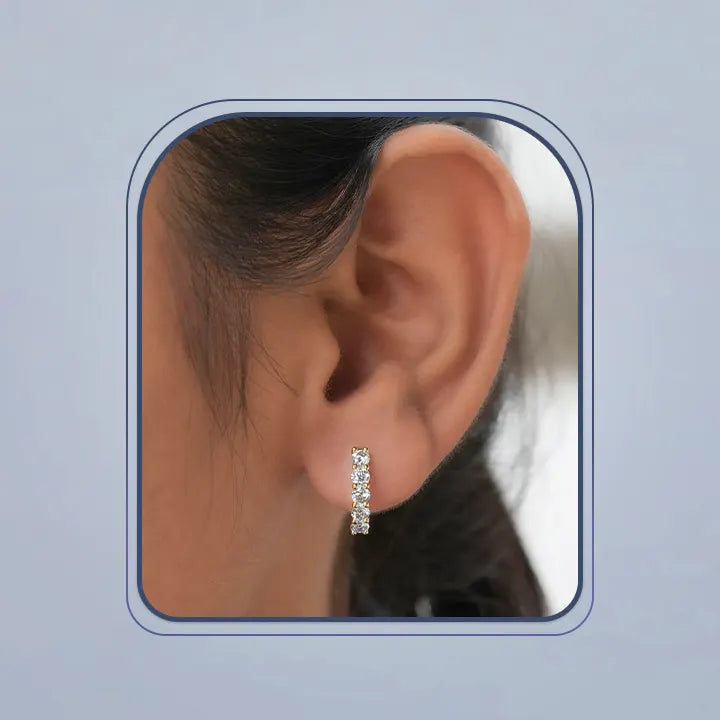Cubic Zirconia (CZ): A Sparkling Marvel in the Jewelry World
Cubic Zirconia, often abbreviated as CZ, is a lab-created gemstone that has taken the jewelry world by storm. Renowned for its dazzling brilliance and affordability, CZ mimics the appearance of a diamond, making it a popular choice for those seeking luxury without breaking the bank. With a hardness rating of 8.5 on the Mohs scale and exceptional clarity, it’s no surprise that CZ has earned its place as one of the most sought-after diamond alternatives.
In recent years, CZ has been at the forefront of jewelry trends. Its versatility and availability in a wide range of cuts and colors make it an ideal gemstone for everything from engagement rings to everyday accessories. Additionally, as consumers increasingly prioritize affordable gemstones and ethical choices, CZ offers a guilt-free option that doesn’t compromise on style or sparkle.

What is Cubic Zirconia and how is it made?
What is Cubic Zirconia?
Cubic Zirconia (CZ) is a dazzling, lab-created gemstone renowned for its stunning resemblance to diamonds. As a type of synthetic gemstone, it is engineered in laboratories to achieve remarkable clarity and brilliance that rivals natural diamonds. This makes it an accessible and ethical choice for jewelry enthusiasts worldwide.
The Origin of Cubic Zirconia
CZ was first discovered as a natural mineral in the 1930s, although it was extremely rare. In the 1970s, scientists developed a method to create lab-created gemstones that replicated its structure. This innovation allowed for the mass production of high-quality cubic zirconia, ensuring its availability for jewelry-making at an affordable price.
How is Cubic Zirconia Made?
Modern cubic zirconia production involves a synthetic process where zirconium dioxide is melted with stabilizing agents like yttrium oxide. This creates flawless crystals with uniform structure and brilliance. Unlike natural diamonds, CZ is entirely man-made, which guarantees consistency in quality and eliminates the ethical concerns associated with mined gemstones.
Key Characteristics of Cubic Zirconia
- Clarity: CZ is virtually flawless, offering unmatched transparency that mimics the clarity of the finest diamonds.
- Brilliance: With a refractive index close to diamonds, CZ delivers a captivating sparkle that’s perfect for all kinds of jewelry.
- Hardness: On the Mohs scale, CZ rates 8.5, making it durable enough for daily wear while slightly softer than diamonds.
- Versatility: Available in various colors and shapes, CZ fits seamlessly into elegant CZ stone settings for rings, necklaces, and more.
How Does Cubic Zirconia Compare to Diamonds?
When it comes to choosing between CZ vs. diamond, understanding the differences can help you make an informed decision. While Cubic Zirconia (CZ) and diamonds may look strikingly similar at first glance, they differ in several ways, from visual appearance to durability and cost.
Visual Differences Between CZ and Diamonds
At a glance, CZ’s brilliance can rival that of a diamond. However, under closer inspection:
- Brilliance: Diamonds emit a mix of white and colored light (fire), while CZ tends to sparkle with more rainbow hues, giving it a slightly different luster.
- Clarity: High-quality cubic zirconia is virtually flawless, whereas natural diamonds often contain inclusions and imperfections.
- Weight: CZ is denser than diamonds, making it feel heavier when compared size for size.
Key Performance Factors
Durability
Diamonds, the hardest natural substance, score a 10 on the Mohs scale, while CZ rates an impressive 8.5.
CZ is durable for everyday wear but is more prone to scratches over time.
Sparkle and Refractive Index
Diamonds have a refractive index of 2.42, offering unparalleled brilliance and fire.
CZ, with a refractive index of 2.15-2.18, still sparkles beautifully but has a more glassy appearance.
Cost Comparison
One of the most significant distinctions between CZ vs. diamond is cost.
- Diamonds: Depending on size, cut, and quality, natural diamonds can cost thousands to millions of dollars.
- Cubic Zirconia: Offers a similar look for a fraction of the price, making it an excellent diamond alternative for budget-conscious buyers.
Environmental and Ethical Benefits
- CZ: As a lab-created gemstone, CZ is conflict-free and eco-friendly, appealing to those seeking sustainable jewelry options.
- Diamonds: Mining diamonds can have significant environmental and ethical implications, although lab-grown diamonds are a more sustainable alternative.
Cubic Zirconia vs. Moissanite
In the debate between cubic zirconia vs. moissanite, each gemstone brings its unique strengths:
- Brilliance: Moissanite’s refractive index (2.65) surpasses both CZ and diamonds, making it sparkle more intensely.
- Durability: Moissanite is harder (9.25 Mohs scale) and more scratch-resistant than CZ.
- Cost: CZ remains the most affordable, while moissanite is pricier but still less expensive than diamonds.
Why Choose Cubic Zirconia?
It's natural to wonder why this stone is so much cheaper than a diamond and whether it has many flaws. Yes, there are some flaws, but what makes this stone special is what it offers at such an affordable price. Let's explore what else this stone has to offer beyond just looks and affordability.
Variety of Styles:
- Available in various cuts such as round, princess, and oval, and comes in a range of colors from classic clear to vibrant hues, allowing for personalized jewelry designs. You can also find cubic zirconia in fancy colors like pink, blue, and green.
Durability:
- Scoring 8-8.5 on the Mohs scale, zirconia is durable enough for everyday wear, though it should be handled with care to prevent scratches. While not as hard as diamonds, it is more resistant to scratching than other gemstones like amethyst or peridot. Essential care tips will give your jewelry a long-lasting shine.
Popular Uses of Cubic Zirconia in Jewelry
Cubic Zirconia (CZ) has revolutionized the jewelry market with its versatility and affordability. Whether you’re looking for timeless classics or modern, trendy pieces, CZ has become the go-to choice for elegant and budget-friendly jewelry.
CZ Engagement Rings and Wedding Bands
CZ shines brilliantly in engagement rings and wedding bands, offering a luxurious look without the hefty price tag.
- CZ Engagement Rings: Couples are increasingly opting for CZ engagement rings to achieve the classic diamond-like sparkle while staying within budget.
- Wedding Bands: CZ adds an extra touch of glamour to wedding bands, making them an enduring favorite for those who prioritize both style and savings.
Trendy CZ Earrings, Necklaces, and Bracelets
CZ is the star of modern, fashion-forward jewelry designs.
- CZ Earrings: From simple studs to dramatic drop earrings, CZ earrings are a versatile accessory that can elevate any outfit.
- Cubic Zirconia Necklaces: Delicate pendants and statement necklaces featuring CZ stones provide an elegant touch for every occasion.
- CZ Bracelets: Tennis bracelets and bangles adorned with CZ stones offer a timeless yet affordable alternative to diamond jewelry.
Customization and Colored CZ Stones
Customization is a significant trend in jewelry, and CZ fits perfectly into this niche.
- Colored CZ Stones: Available in a wide range of colors, CZ allows for personalized designs that suit every style and personality. Whether it’s a sapphire-blue CZ for a regal look or a ruby-red stone for bold flair, the options are endless.
- Trendy CZ Jewelry Designs: Jewelers are pushing creative boundaries with trendy CZ jewelry designs, crafting unique pieces that showcase the gemstone’s versatility.
How to Identify High-Quality Cubic Zirconia
When shopping for high-quality cubic zirconia jewelry, understanding what to look for can make all the difference. Just like diamonds, Cubic Zirconia (CZ) stones vary in quality. By recognizing grading standards, evaluating craftsmanship, and following a practical cubic zirconia buying guide, you can confidently select a piece that meets your expectations.
Understanding Grading Standards for CZ Stones
Unlike diamonds, CZ stones don’t have an industry-standard grading system, but quality is assessed based on the following factors:
- Clarity: A high-quality CZ stone is completely flawless, with no inclusions or blemishes visible to the naked eye.
- Cut: Expertly cut CZ stones will maximize brilliance and sparkle, resembling the finest diamond cuts.
- Color: Premium CZ stones are colorless and free from any yellowish or cloudy tones. Colored CZ stones should exhibit vibrant, even hues.
When purchasing, inquire about the CZ jewelry quality standards adhered to by the jeweler to ensure you’re getting a superior product.
The Importance of Craftsmanship in Settings
The setting plays a crucial role in enhancing the appearance and longevity of CZ jewelry:
- Materials: Look for durable metals like sterling silver, platinum, or gold to complement and protect the CZ stone.
- Precision: High-quality settings should hold the stone securely without visible gaps or uneven prongs.
- Design: Well-crafted designs highlight the brilliance of the CZ stone while ensuring comfort and wearability.
Tips for Choosing Durable and Well-Made CZ Jewelry
- Inspect the Stone: Examine the stone under good lighting to check for clarity, brilliance, and any visible defects.
- Verify the Weight: CZ stones are denser than diamonds, so they may feel slightly heavier in well-made jewelry.
- Check for Coatings: Some CZ stones are coated with a diamond-like layer to enhance brilliance. Ensure the coating is uniform and scratch-free.
- Ask for Certifications: While not standard for CZ, some reputable jewelers may provide details about the stone’s quality and origin.
Cubic Zirconia vs. Other Diamond Alternatives
In the world of diamond alternatives, options like moissanite, lab-grown diamonds, and other synthetic stones compete with cubic zirconia (CZ). While each alternative has its unique appeal, CZ stands out for its affordability, versatility, and beauty. Let’s explore how CZ vs. diamond, cubic zirconia vs. moissanite, and other alternatives compare in key areas.
Cubic Zirconia vs. Moissanite
Moissanite and CZ are often compared due to their visual similarities to diamonds, but there are distinct differences:
- Brilliance: Moissanite’s higher refractive index (2.65) gives it a fiery sparkle compared to CZ’s glassier shine (2.15).
- Durability: Moissanite scores 9.25 on the Mohs scale, making it more resistant to scratches than CZ (8.5).
- Cost: While more affordable than diamonds, moissanite is significantly pricier than CZ.
- Appearance: CZ is known for its flawless clarity, while moissanite may have slight inclusions depending on its quality.
Cubic Zirconia vs. Lab-Grown Diamonds
Lab-grown diamonds are chemically and physically identical to natural diamonds, but how do they stack up against CZ?
- Composition: Lab-grown diamonds are real diamonds created in a lab, while CZ is a synthetic gemstone with a different composition.
- Brilliance and Fire: Lab-grown diamonds offer a natural diamond’s brilliance and fire, whereas CZ has a more rainbow-like sparkle.
- Durability: With a Mohs hardness of 10, lab-grown diamonds are far more durable than CZ.
- Cost: CZ is the most affordable option, with lab-grown diamonds being more budget-friendly than mined diamonds but still far pricier than CZ.
Cubic Zirconia vs. Other Synthetic Stones
Other synthetic stones like white sapphire and zircon also vie for attention in the market:
- White Sapphire: Known for its subtle sparkle, white sapphire lacks the brilliance and fire of CZ.
- Zircon: While natural zircon has impressive fire, it’s more expensive and less readily available than CZ.
- CZ’s Edge: CZ combines affordability, flawlessness, and availability, making it a top choice for jewelry enthusiasts seeking value.
Myths and Misconceptions About Cubic Zirconia
Despite its popularity, Cubic Zirconia (CZ) is often subject to myths and misunderstandings. These misconceptions overshadow its true brilliance and versatility, leading some to underestimate this remarkable gemstone. Let’s debunk the most common myths about cubic zirconia and explore why CZ deserves greater recognition.
Myth 1: “Cubic Zirconia is Cheap and Low-Quality”
One of the biggest misconceptions about CZ is that it’s a low-grade substitute for diamonds. In reality:
- High-Quality CZ Stones: Modern CZ is crafted to perfection, offering flawless clarity and brilliance that rivals natural diamonds.
- Affordable, Not Inferior: CZ is affordable because it’s lab-created, not because it’s low quality. Its affordability makes fine jewelry accessible without compromising on beauty.
Myth 2: “CZ Looks Fake Compared to Diamonds”
Some believe that CZ lacks the authenticity of diamonds. However:
- Visual Appeal: CZ’s fire and brilliance often make it indistinguishable from diamonds to the untrained eye.
- Customization: CZ stones come in various cuts, sizes, and colors, allowing for personalized designs that stand out.
Myth 3: “CZ Doesn’t Last”
Durability concerns often deter buyers, but CZ is more resilient than many realize:
- Mohs Hardness Scale: With a hardness of 8.5, CZ is durable enough for everyday wear.
- Proper Care: With regular cleaning and proper storage, CZ jewelry retains its sparkle for years.
Myth 4: “CZ is Only for Costume Jewelry”
Another common myth is that CZ is unsuitable for fine jewelry. In truth:
- Versatile Applications: CZ is widely used in engagement rings, wedding bands, and luxury designs.
- Designer Favorite: Many jewelers incorporate high-quality cubic zirconia into their collections for its versatility and brilliance.
Wrap up
Cubic zirconia has emerged as a brilliant alternative to diamonds, offering stunning beauty at a more accessible price. Since its discovery in the 1970s, this gemstone has captivated jewelry enthusiasts with its high refractive index, resulting in exceptional sparkle and fire that closely mimics the allure of diamonds.
While it may not match the intrinsic value of natural diamonds, it provides a similar aesthetic at a fraction of the cost—around $160 per carat compared to $11,500 for a high-quality diamond of the same size. Available in various cuts and colors, this stone is durable with a Mohs scale rating of 8-8.5, making it suitable for everyday wear.
Although it is a popular choice, other alternative like moissanite offer superior luster and strength, making it worth considering for those seeking additional benefits. Overall, it stands out for its affordability and elegance, making it a valuable option for those who desire the sparkle of diamonds without the substantial expense.
FAQs
1. Is Cubic zirconia a real diamond?
NO, Although cubic zirconia gemstones are synthetic, they are genuine stones in their own right. Unlike natural diamonds, which are carbon-based gems formed naturally, CZs are man-made.
2. Which Cubic Zirconia is the best?
It is evaluated using the same grading scale applied to commercial diamonds. The top grade is AAAAA, or 5A, which signifies exceptional clarity.
3. Which is better, mossanite or CZ?
Moissanite is better in terms of brilliance, durability, and overall quality, making it a more premium choice for those seeking a closer match to natural diamonds.
4. Where to buy Cubic Zirconia and Mossanite jewelry?
You can buy jewelry with mossanite stone from our website. We have a diverse collection of all types of mossanite jewelry for every occasion. Fill your life with brightness, and your face will be adorned with a smile with golden birdjewels.

.png?v=74971505631319126241739980080)

.png?v=170379015109479064061739980109)
 Solitaire Ring
Solitaire Ring
 Accent Ring
Accent Ring
 Halo Ring
Halo Ring
 Bridal Set
Bridal Set
 Toi-Moi Rings
Toi-Moi Rings
 Three Stone Ring
Three Stone Ring
 Five Stone Ring
Five Stone Ring
 Pave band
Pave band
 Eternity Band
Eternity Band
 Bezel Set
Bezel Set
 Channel Set
Channel Set
 Studs and Earrings
Studs and Earrings
 Bracelet
Bracelet
 Necklace
Necklace
 Men's jewelry
Men's jewelry
 Brilliant
Brilliant
 Old Cut
Old Cut
 Step Cut
Step Cut
 Matching Pair
Matching Pair


 Vintage Ring
Vintage Ring
 Dainty Band
Dainty Band
 Gemstone Jewelry
Gemstone Jewelry


![[Diamond alternatives stones to know and understand about them]-[golden bird jewels]](http://www.goldenbirdjewels.com/cdn/shop/articles/2_The_cubic_Zirconia_Important_things_to_know_2000X1000_1.webp?v=1741349953&width=5000)





![[Which hand to wear a promise ring]-[Goldenbird Jewels]](http://www.goldenbirdjewels.com/cdn/shop/articles/Which_hand_to_wear_a_promise_ring_1024x1024.webp?v=1735388893)
![[How To Care For Your Moissanite Engagement Ring]-[Goldenbird Jewels]](http://www.goldenbirdjewels.com/cdn/shop/articles/banner_image_1_1024x1024.jpg?v=1735364626)

![Image of engagement ring and wedding band with couple indulging in romance at the beach, [Text] Engagement ring and wedding band, whiich goes first](http://www.goldenbirdjewels.com/cdn/shop/articles/Banner_Image_2_1024x1024.webp?v=1735283814)

![two emerald rings by goldenbird jewels, showcasing in sleek grey background, with jewelry box, [Text] Emerald ring style for 2025](http://www.goldenbirdjewels.com/cdn/shop/articles/10_Emerald_Ring_Styles_for_2025_Main_Banner_2048X1024_08ce3abe-68fd-4164-8e84-630ea85fe82c_1024x1024.webp?v=1735044302)


